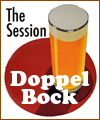Dreaming of Delightful Doppelbock
- Posted by Josh on January 05, 2008 at 11:14am
- Categories: Commercial Brews, Homebrews, The Session
- No Comments »
 Yesterday was the 11th Beer Blogging Session. This month it is hosted by Brewvana, and the topic is Doppelbock, the Illuminator.
Yesterday was the 11th Beer Blogging Session. This month it is hosted by Brewvana, and the topic is Doppelbock, the Illuminator.
I’m hoping they’ll still include my post in the round-up despite the fact that I’m a day late. I meant to write this last night, but my wife and I had company over, and they didn’t leave until close to midnight. After that, I was too tired to post and instead went straight to bed.
Like my post for last month’s session, I’ll be talking about more than one beer.
Doppelbock Deathmatch
A little over a year ago I tried a horizontal tasting of German doppelbocks. In the line-up that night were Paulaner Salvator, Spaten Optimator, and Ayinger Celebrator. I enjoyed this style and these three beers so much that I sought other traditional doppelbocks over the next few weeks and found Weihenstephaner Korbinian and Tucher Bajuvator.
In the original tasting – which happened to include the three most famous examples of the style – I discovered a delightful breadth to the style. All three of these beers are very different from one another. Their similarities – governed by the style – were a darkish brown color (though Celebrator was distinctly darker than the other two), strength (though Celebrator is notably lower in alcohol than the other two), and a chewy, malt-oriented flavor.
The hands-down winner was Ayinger Celebrator. It remains one of my all-time favorite beers. Paulaner’s Salvator is also a decidedly delicious product, and took home silver that evening. Optimator is a very tasty brew, but it simply couldn’t muscle its way into the company of the other two, taking a distant third place.
The follow-up tastings of Tucher’s and Weihenstephaner’s doppelbocks resulted in a new third and fourth place (respectively), with Spaten’s Optimator still rounding out the set in last place. The Tucher Bajuvator was very characteristic of the style and was very close to a tie with Salvator. Weihenstephaner Korbinian was a very interesting brew with some flavors that are familiar from other Doppelbocks. But, at the same time, it had the greatest variance in flavors – almost cloyingly sweet aroma, but a more bitter finish. A good beer, but no match for Celebrator.
To remind myself of some of the brews, I bought a bottle of Optimator and a bottle of Bajuvator last night. But the company we had over last night were more interested in my homebrew, so we drank that instead of doppelbock. I did get a chance to have the Optimator before everyone arrived. Admittedly, it was better than I remembered. In fact, I updated my rating on RateBeer.com with my latest impression of the beer. It is now tied for fourth place with Weihenstephaner Korbinian.
Perhaps I’ll get around to trying the Bajuvator this afternoon/evening…
Hump’s Emancipator Doppelbock
What would a post be without mention of homebrew?
I have made one doppelbock during my years of home brewing. I formulated the recipe pretty early on – and prior to reading Ray Daniels’ Designing Great Beers and, admittedly, prior to actually trying any authentic doppelbocks (at the time, Georgia law prohibited the sale of beers stronger than 6.5%, so these brews were unavailable here). Further major impediments included the fact that I was still doing a partial boil (cook 2 gallons of super-strong beer and then dilute with 3 gallons of cold water to make a 5 gallon batch). I was also getting 100% of the fermentables from extract – specialty grains were steeped, no mash was ever performed. Finally, I had no temperature-controlled environment in which to lager the beer. What I did have was an uninsulated storage room that – because I brewed in winter – got very cold and maintained temperatures that were cool enough for lager brewing (although with a temperature swing of about 10 degrees between day and night).
Despite these major obstacles, the beer I designed and made was actually an awesome brew and a good example of the style. Because I was doing a partial boil, I had to use 8 ounces of hops! That would usually make a beer quite hoppy, but partial-boil brewing is very inefficient when it comes to extracting bitterness and flavor from hops.
I was sad to see this batch go. I had saved a pop-top 1-liter bottle of the brew for a special occasion. I opened it on the following New Year’s Eve and was quite disappointed to see that the gasket of the pop-top had not sealed properly: the last bottle of precious Emancipator was flat…
Oh, well. I still have very fond memories of it. I should probably design a new recipe – that includes a full-volume boil and mashing of grains – to see if I can make an even better one.